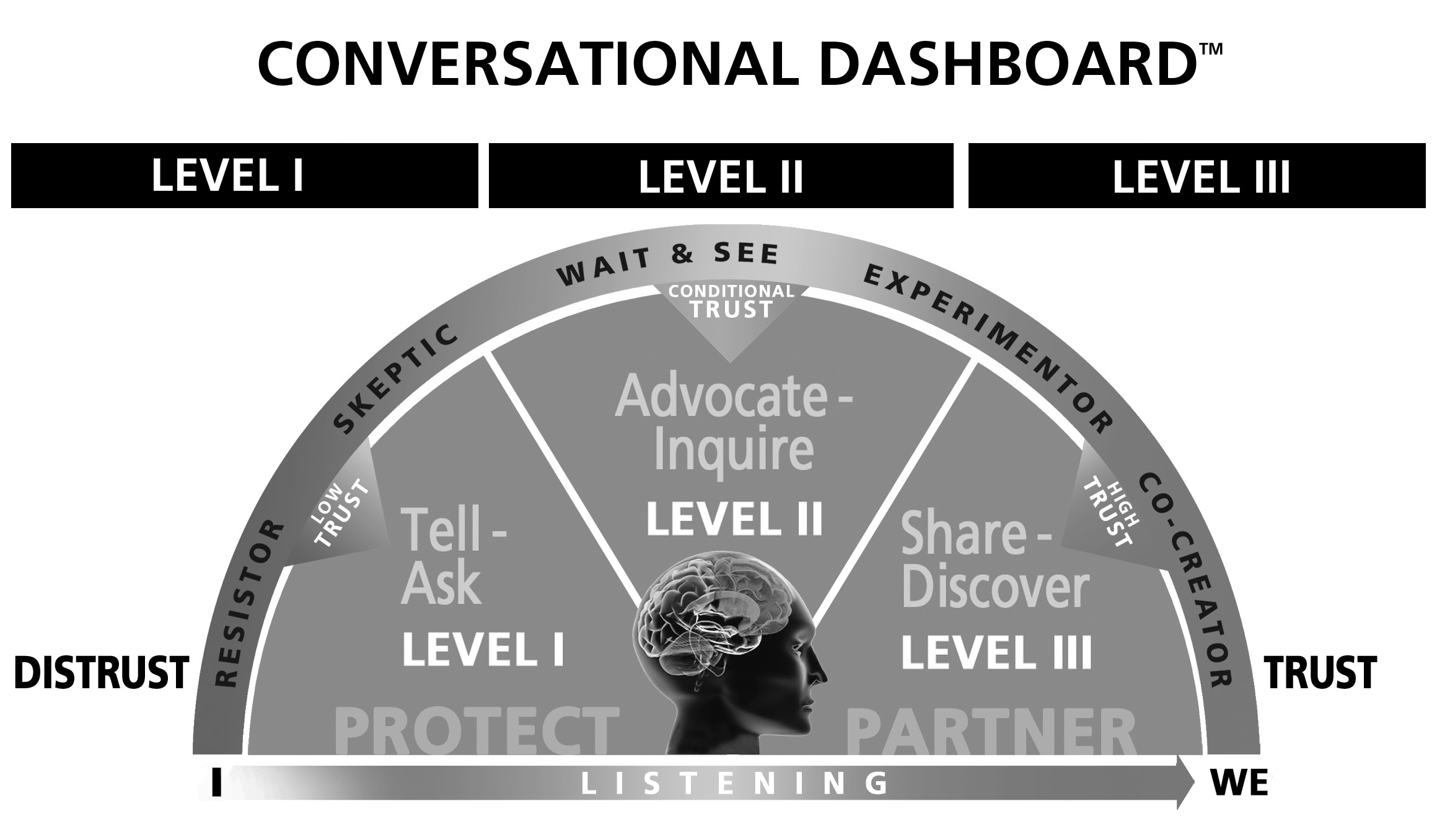Conversational Intelligence
My whole life I’ve been a student of success. Many people are surprised to learn that it’s not always technical expertise, extensive training, or even the highest I.Q. that creates sustainable success. There are a range of other skills that are critically important.
Learn to Be a Master Conversationalist
One of those important skills is conversation. That’s right. Learning to be a master conversationalist can help propel your success.
Author Judith Glaser is an expert in conversations. Her new book, Conversational Intelligence: How Great Leaders Build Trust and Get Extraordinary Results makes the latest research from neuroscience accessible and practical for all of us to apply immediately. Judith is the CEO of Benchmark Communications, Inc. whose clients range from American Express to IBM. She helps people boost Conversational Intelligence (C-IQ). I reached out to her to learn more about her work.
A Simple Conversation is Anything But
Most of us think of conversations as casual, but you reveal that they are much more than what they appear. What has your research revealed about the power and importance of conversation?
Conversational Intelligence is the intelligence hardwired into every human being to enable us to navigate successfully with others. Through language and conversations, we learn to build trust, to bond, to grow to each other, and to create our societies. There is no more powerful skill hardwired into every human being than the wisdom of conversations.
Conversations are not just the words we use when engaging with others. Our 35 years of research shows that conversations are the golden thread that keeps human beings connected relationally, neuro-chemically, and energetically. Our brain has the ability to ‘signal’ us when the connection feels like ‘distrust’ or when we feel ‘trust.’
Conversations happen like this:
Our conversations take place against the backdrop of our brain chemistry. Our state of mind – and our level of trust and distrust – directly impacts what kinds of conversations we have and how we interpret them. Equally so, our conversations impact how much we trust someone, or don’t.
Brain chemistry is like a symphony, moving us to higher or lower levels of trust or distrust as we converse with others. The brain is where trust lives or dies, and if we are threatened during our conversations, we activate the distrust networks, and if we are feeling trust, we activate the trust networks. According to Angelika Dimoka, Temple University, Fox School of Business, distrust takes place in the lower brain (the amygdala and limbic areas) and trust takes place in the higher brain (the prefrontal cortex).
In other words, the distrust, or fear network, closes down most of our thinking brain, giving power to our emotional and action brain, while the trust network opens up access to our executive brain – the neo-cortex and prefrontal cortex.
3 Levels of Conversation
What are the 3 Levels of Conversation?
All human beings, from the time they were born, can access 3 Levels of Conversation. We are hardwired for all 3.
Level I: Informational conversations are transactional – we are most interested in giving or receiving information. These conversations remain at Level I, and don’t activate fear networks, stimulate questions about the impact of the transaction, nor lead to deep exploration of consequences or building strategies and plans. This level is informational.
Level II: Positional conversations are designed to bring clarity, understanding and influence how the other person feels and thinks. We advocate our own opinions and inquire into others’ perspectives. If this inquiry is based on shared curiosity and respect, conversations will be healthy, and the networks of trust will be activated.
But if one or more participants are more focused on making a point or taking a stand, conversations turn to debate, signaling to our brain that we are dealing not with a ‘friend’ but a ‘foe.’ In response, the brain releases cortisol and closes down, or the amygdala becomes hijacked.

Conversational Intelligence enables us to learn to control this release. Rather than jumping to conclusions, we can instead “wait and see” how the other person reacts. If the other person shows trust, fairness, or reciprocity, then we can sustain healthy brain chemistry and build trust, creating a culture where people are open to share, discover and co-create.
Level III: Relational Conversations build meaning and create connections, which release oxytocin, the bonding hormone. When we care about what others think and feel, our brain senses not only safety; the prefrontal cortex ‘reads’ oxytocin as a signal to trust and open up. As a result, our conversations become innovative, co-creational and energizing. These conversations are the most likely to result in higher levels of partnering, trust, and innovation.
Reaching Level III
How often is it possible for us to reach level III?
It’s always possible to reach Level III, however it’s not always probable. Our 35 years of research has revealed that most conversations live in Level I, or II – and the reasons they do are quite fascinating.
We raise our children in Level I, Transactional Conversations, or Level II, Positional Conversations, where we learn to persuade them of our point of view. We also send people to school to learn how to engage in Level II, Positional Conversations, and as we reward people for being great at influence, we lock in, or hardwire, the positional conversations so they become our ‘success strategies.’
Level III – Transformational Conversations
As we’ve studied patterns of interaction, we have scanned millions of people and how they communicate, and Level III Conversations are the lead represented in companies. They are about creating safe environments for ‘sharing’ what we know with others – and ‘discovering’ what we don’t know we know. Most companies and families spend more time on Level I and II because we have been rewarding these conversational strategies.
Moving forward, we are having companies, teams and individuals around the globe from 65 countries, asking us how to enable more Level III (Transformational and Co-creational Conversations) to emerge inside of companies. This has radically changed the ratio of I, II and III in companies. And when we open the space for more Level III, ‘great music plays.’
Our brain works like a symphony. All parts of our brain have a level of activation, and as we give leaders the skills to make distinctions between I, II, and III Levels of conversation, they soar not just as leaders, they gain access to powers they never thought or knew they had: higher levels of wisdom, integrity, strategies, empathy, foresight, insight and trust.
How do the different parts of our brain affect our communication?
Our brain works like a symphony. All parts of our brain have a level of activation and influence on what we think, feel, imagine and do.
 Move from Fear to Trust
Move from Fear to Trust
You provide some examples of people working in some type of fear. What technique helps move away from fear?
When people TRUST themselves and TRUST each other, everything changes. Fear dissolves; people open up and share what is on their minds. Here are some suggestions to move from fear and distrust to trust.
BRAIN T.R.U.S.T.
- Establish a foundation of T.R.U.S.T.
- Transparency – Being open about what’s on your mind; break the code of silence.
- Focus on quelling threats through sharing information
- Requesting what you need from others
- Keeping people in the loop
- Transparency – Being open about what’s on your mind; break the code of silence.
- Outcome: Ensuring others know what you know
- Relationship – Building strong relationships before working on tasks.
- Determine what is important to others
- Steep into others shoes
- Have open dialogues about what is important to others
- Outcome: getting in sync with others
- Understanding – Understanding what others mean; create shared understanding:
- Setting context for understanding
- Listening actively – really hearing what others say
- Using people’s feedback to gain understanding
- Outcome: seeing the world from other’s perspectives and validating each other’s perspectives
- Shared Success – focus on shared success and creating shared meaning with others
- Determining what is important to others
- Understanding what success looks like in the other’s mind
- Aligning perspectives
- Outcome: co-creating a shared view of reality and of future possibilities
- Truth – focus on closing reality gaps with others
- Having both candor and caring in your approach with others
- Providing insights to narrow misunderstandings
- Letting others know where they stand with candor and caring
- Outcome: narrowing reality gaps
Conversational Intelligence: How Great Leaders Build Trust and Get Extraordinary Results

